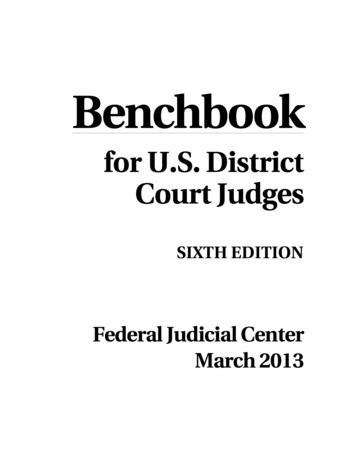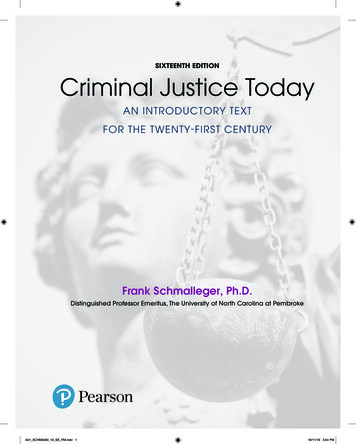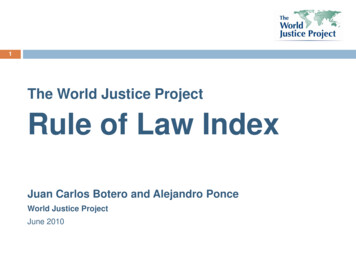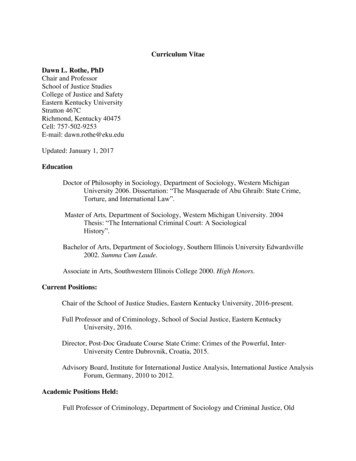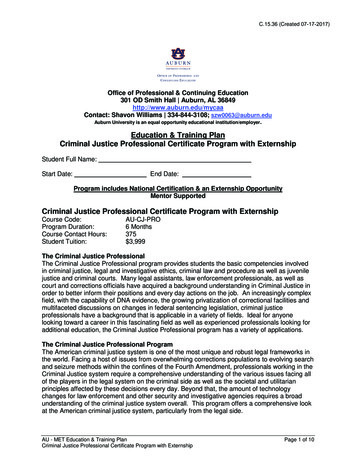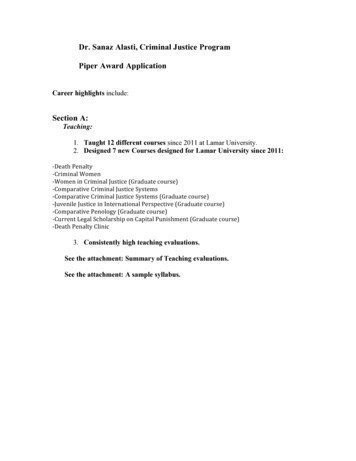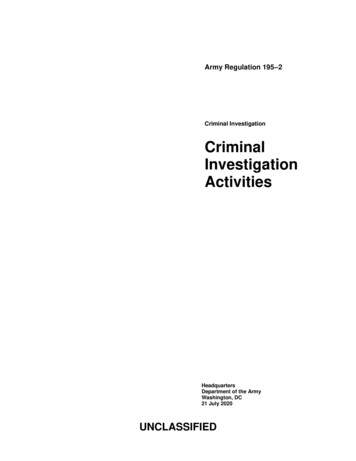
Transcription
Army Regulation 195–2Criminal artersDepartment of the ArmyWashington, DC21 July 2020UNCLASSIFIED
SUMMARY of CHANGEAR 195–2Criminal Investigation ActivitiesThis major revision, dated 21 July 2020-oRescinds Army Directive 2020–02 (Designee to Claim of Privilege Under Military Rule of Evidence 506) (para1–4).oAdds the requirement for the submission of fingerprint cards and deoxyribonucleic acid collection kits (para 1–4c(2)).oAdds the authorization for Criminal Investigation Division supervisors to sign completed DA Forms 4833 (para1–4e).oEstablishes the criteria in which U.S. Army Criminal Investigation Command investigates CTA–50 thefts (para3–3a(1)(c)).oEstablishes the criteria in which U.S. Army Criminal Investigation Command investigates thefts of prescriptionmedication (para 3–3a(2)(b)).oEstablishes criteria in which U.S. Army Criminal Investigation Command investigations of drug offenses at theentrance to a military installation when the subject is non-DoD affiliated (para 3–3a(2)(c)).oEstablishes the criteria in which U.S. Army Criminal Investigation Command will investigate aggravated assaultsassociated with strangulation and suffocation (para 3–3a(10)).oAdds legal coordination in accordance with DODI 5505.03 (para 3–16b).oAdds sharing criminal justice information in accordance with DODI 5525.16 (para 3–16f).oAdds authority to carry alternate duty weapon in accordance with DODD 5210.56 (para 3–26b).oAdds requirement for submission of fingerprints and other criminal history to federal databases (para 5–2m).oAdjusts investigative responsibilities of the U.S. Army Criminal Investigation Command, installation lawenforcement, and unit commander based on the changes associated with the Military Justice Act of 2016 (app B).oDeletes sensitive items in appendix D and adds the information into appendix B (app B).oDeletes preparation of the DA Form 2804 (Crime Records Data Reference) (app C).oChanges report of investigation and DA Form 3975 to law enforcement report (throughout).oRescinds the DA Form 2804 (Crime Records Data Reference).
HeadquartersDepartment of the ArmyWashington, DC21 July 2020*Army Regulation 195–2Effective 21 August 2020Criminal InvestigationCriminal Investigation ActivitiesUnited States, and the U.S. Army Reserve, unless otherwise stated. It also applies to the Army National Guard when inactive Federal service, as prescribed inSection 802, Title 10, United States Code.History. This publication is a major revision.Summary. This publication establishespolicies on criminal investigation activities, including the utilization, control, andinvestigative responsibilities of all personnel assigned to the U.S. Army Criminal Investigation Command elements. Italso delineates responsibility and authority between Military Police and the U.S.Army Criminal Investigation Command.provisions in accordance with AR 11–2and identifies key internal controls thatmust be evaluated (see app D).Supplementation. Supplementationof this regulation and establishment ofProponent and exception authority. command and local forms are prohibitedThe proponent of this regulation is the without prior approval from the ProvostProvost Marshal General. The proponent Marshal General (DAPM–MPO–LE),has the authority to approve exceptions or 2800 Army Pentagon, Washington, DCwaivers to this regulation that are con- 20310–2800.sistent with controlling law and regulaSuggested improvements. Userstions. The proponent may delegate thisare invited to send comments and sugapproval authority, in writing, to a divigested improvements on DA Form 2028sion chief within the proponent agency or(Recommended Changes to Publicationsits direct reporting unit or field operatingand Blank Forms) directly to the U.S.agency, in the grade of colonel or the ciArmy Criminal Investigation Commandvilian equivalent. Activities may request a(CIOP–PO), 27130 Telegraph Road,waiver to this regulation by providing jusQuantico, VA 22153–2253.tification that includes a full analysis ofthe expected benefits and must include Distribution. This regulation is availaformal review by the activity’s senior le- ble in electronic media only and is ingal officer. All waiver requests will be en- tended for the Regular Army and the U.S.dorsed by the commander or senior leader Army National Guard/U.S. Army Naof the requesting activity and forwarded tional Guard of the United States, and thethrough their higher headquarters to the U.S Army Reserve.policy proponent. Refer to AR 25–30 forspecific guidance.Applicability. This regulation appliesto the Regular Army, the Army National Army internal control process.Guard/Army National Guard of the This regulation contains internal controlContents (Listed by paragraph and page number)Chapter 1General, page 1Purpose 1–1, page 1References and forms 1–2, page 1Explanation of abbreviations and terms 1–3, page 1Responsibilities 1–4, page 1Records management (recordkeeping) requirements 1–5, page 2Objectives 1–6, page 3Criminal incident policies 1–7, page 3Investigative policies 1–8, page 3Chapter 2U.S. Army Criminal Investigation Command Organization, page 5General 2–1, page 5U.S. Army Criminal Investigation Command support to the Army in the field 2–2, page 5*This regulation supersedes AR 195-2, dated 9 June 2014; rescinds DA Form 2804, dated 1 January 1980; and AD 2020-02, dated 16 March 2020.AR 195–2 21 July 2020UNCLASSIFIEDi
Contents—ContinuedChapter 3Criminal Investigation Activities, page 6Section IGeneral, page 6Investigative authority of the Army 3–1, page 6U.S. Army Criminal Investigation Command investigative responsibility 3–2, page 6Investigative responsibility of the U.S. Army Criminal Investigation Command and military police 3–3, page 7Assumption of investigative responsibility by the U.S. Army Criminal Investigation Command 3–4, page 10Agreements between the U.S. Army Criminal Investigation Command and installation law enforcement activities 3–5, page 10Referral of investigations 3–6, page 10Army Substance Abuse Program 3–7, page 10Immigration customs enforcement and postal matters 3–8, page 10Section IICrime Prevention Surveys, Protective Services, Procurement Fraud Program, and Criminal Intelligence Program, page 11Crime prevention surveys 3–9, page 11Protective services 3–10, page 11Procurement Fraud Program 3–11, page 11Criminal intelligence 3–12, page 11Law enforcement reporting of suspicious activity 3–13, page 11Section IIIOperational Considerations, page 11Freedom of movement 3–14, page 11Crime scenes 3–15, page 11Coordination 3–16, page 12Access to Army facilities and records 3–17, page 12Security clearances and background investigations 3–18, page 12U.S. Army Criminal Investigation Command use of the National Crime Information Center 3–19, page 13Warning of rights 3–20, page 13Section IVU.S. Army Criminal Investigation Command Special Agents, page 13General 3–21, page 13Utilization 3–22, page 13Authority to apprehend or detain 3–23, page 14Authority to search and seize 3–24, page 14Authority to administer oaths 3–25, page 15Firearms 3–26, page 15Civilian clothing 3–27, page 15Billets and messes 3–28, page 15Disclosure of rank or grade 3–29, page 15Retention and use of investigative property 3–30, page 15Standards of conduct 3–31, page 16Section VU.S. Army Criminal Investigation Command Drug Suppression Operations in Foreign Countries, page 16Purpose 3–32, page 16Definitions 3–33, page 16Policy considerations 3–34, page 16Approvals and coordination 3–35, page 17Section VIU.S. Army Criminal Investigation Command Support to the Army and Air Force Exchange Service, page 17AR 195–2 21 July 2020ii
Contents—ContinuedPurpose 3–36, page 17Air Force Office of Special Investigations 3–37, page 17Air Force Office of Special Investigations responsibilities 3–38, page 17Army law enforcement responsibilities 3–39, page 18General guidelines on types of crimes 3–40, page 18Chapter 4Investigative Records, Files, and Reports, page 19Policy 4–1, page 19Preparation and maintenance 4–2, page 19Release and use of information 4–3, page 19Individual requests for access to, or amendment of, U.S. Army Criminal Investigation Command law enforcementreports 4–4, page 21Chapter 5Army Crime Records Center, U.S. Army Criminal Investigation Command, page 21General 5–1, page 21Functions 5–2, page 21Routine investigative name checks 5–3, page 22Immediate name checks 5–4, page 22Requesting U.S. Army Crimes Records Center files and reports 5–5, page 22Use of information contained in U.S. Army Criminal Investigation Command and Military Police reports 5–6, page 23Chapter 6U.S. Army Criminal Investigation Laboratory, page 23General 6–1, page 23Responsibilities 6–2, page 23Request for examination 6–3, page 23Court appearance 6–4, page 23U.S. Army Criminal Investigation Laboratory quality management documents and accreditation documents 6–5, page 24On scene assistance 6–6, page 24AppendixesA. References, page 25B. Offense Investigative Responsibility, page 30C. Telephone Name Check Format, page 38D. Internal Control Evaluation, page 39Table ListTable B–1: Offense investigative responsibility, page 30GlossaryAR 195–2 21 July 2020iii
Chapter 1General1 –1. PurposeThis regulation prescribes policies and procedures pertaining to criminal investigation activities within the Departmentof the Army (DA). It prescribes the authority for conducting criminal investigations, crime prevention surveys, protective service missions, force protection and antiterrorism efforts and the collection, retention, and dissemination ofcriminal information. It delineates responsibility and authority between installation law enforcement (LE) activitiesand the U.S. Army Criminal Investigation Command (USACIDC).1 –2. References and formsSee appendix A.1 –3. Explanation of abbreviations and termsSee the glossary.1 –4. Responsibilitiesa. Secretary of the Army. Appoints the Commanding General (CG), USACIDC, under the provisions of MilitaryRule of Evidence (MRE) 506, Government information, as his designee to claim the government information privilegeover law enforcement information contained in policies and criminal investigation operational procedures.b. Commanders of Army commands, Army service component commands, and direct reporting units. Commandersof ACOMs, ASCCs, and DRUs, within their respective areas of responsibilities, will ensure that known or suspectedcriminal activity is reported to the installation LE activity and, when appropriate, to USACIDC for investigation.c. Senior commanders. Senior commanders, within their respective areas of responsibilities, will—(1) Support the USACIDC by providing facilities and support required by the USACIDC mission and authorizedby applicable regulations or memorandum of understanding (MOU) to assist the USACIDC in meeting the criminalinvestigative, crime prevention, force protection, antiterrorism, and protective service requirements of subordinatecommands, installations, and other supported Army activities.(2) Ensure subordinate law enforcement elements process fingerprint cards and deoxyribonucleic acid (DNA) collection kits in accordance with DODI 5505.11 and DODI 5505.14.d. Commanding General, U.S. Army Training and Doctrine Command. The CG, TRADOC, will oversee the formal training of USACIDC personnel at TRADOC schools to meet the requirements of USACIDC.e. Commanding General, U.S. Army Criminal Investigation Command. The CG, USACIDC, exercises commandauthority, direction, and control of Army criminal investigative activities worldwide. The CG, USACIDC will—(1) Establish policies for the release of information from, and the amendment of, criminal investigation recordsand law enforcement reports (LERs).(2) Establish policies and criminal investigation operational procedures that govern all aspects of USACIDC operations, including, but not limited to, internal procedures, practices, discipline, permissions, interrogations, interviews, polygraphs, tactics, and techniques.(3) Evaluate Army LE polygraph program activities and provide membership on DOD polygraph committees.(4) Maintain overall responsibility for Army investigations of offenses involving controlled substances listed inTitle 21, United States Code, Section 812 (21 USC 812).(5) Conduct preliminary investigation into losses of all Category I and Category II AA&E items, regardless ofdollar value, to determine if a crime was committed (see AR 190–11, app b).(6) Conduct preliminary investigation into losses of Category III and Category IV items meeting the quantitieslisted in 190–11, appendix E, regardless of dollar value, to determine if a crime was committed.(7) Conduct investigations of actual or attempted break-ins or armed robberies of AA&E storage facilities.(8) Conduct preliminary investigations into the theft, suspected or attempted theft, loss or recovery of any nuclear,biological, or chemical weapons and/or agents in any quantity.(9) Plan for and provide USACIDC support for each contingency plan maintained by Headquarters, Departmentof the Army (HQDA) and its subordinate commands. Plans for criminal investigative support will be coordinated withthe commander responsible for the overall contingency plan.(10) Ensure that the command and its field elements report known or suspected espionage, indicators of potentialterrorist associated insider threats or extremist activity, and any of the other reportable matters of counterintelligenceAR 195–2 21 July 20201
(CI) interest defined in AR 381–12 and DODD 5240.06 to the nearest Army CI office within 72 hours of receipt ofthe information.f. Commanders, supervisors, and special agents of subordinate U.S. Army Criminal Investigation Command elements. Commanders, supervisors, and special agents of subordinate USACIDC elements will—(1) Provide criminal investigative services to the U.S. Army on an area basis.(2) Provide reports and or statistical data to installation activity directors to provide supported commands with therelative number and types of serious crimes and incidents investigated, subjects identified, value of property stolen orrecovered, and other information reflecting the status of discipline, law, and order necessary for the completion ofreports required by HQDA.(3) Provide statistical data necessary to support locally established reports within the administrative and recordkeeping capabilities of the supporting USACIDC element.(4) Ensure fingerprint cards and DNA collection kits are processed in accordance with DODI 5505.11 and DODI5505.14.g. Commanders and supervisors receiving reports. Commanders and supervisors receiving USACIDC reports foraction or receiving action copies of final USACIDC LERs pertaining to a member of their organization will—(1) Reply within 60 days through local command channels (using DA Form 4833 (Commander’s Report of Disciplinary or Administrative Action)), ensuring that battalion commanders or the first lieutenant colonel in the chain ofcommand, in accordance with applicable regulations and USACIDC directives, completes the DA Form 4833 andreturns to the USACIDC element preparing the LER, indicating the judicial, nonjudicial, or administrative action, orlack thereof, taken against persons listed in the subject/suspect block of the final LER. Only a colonel (O–6) or higherwith special court-martial convening authority will complete the DA Form 4833 within 60 days in cases of rape, sexualassault, and, forcible sodomy, in violation of Article 120, Uniform Military Code of Justice (UCMJ) (UCMJ, Art.120), or corresponding civilian statutes, and all attempts to commit such offenses, in violation of UCMJ, Art. 80,UCMJ, or corresponding civilian statutes. Changes to judicial, nonjudicial, or administrative action resulting fromsubsequent appellate action will also be reported by commanders and supervisors to the USACIDC. The report ofaction taken is necessary to ensure completion of investigative files, to protect the rights of individuals involved, andto provide commanders with information for force protection and the state of discipline in their command. CriminalInvestigative Division (CID) supervisors (special agent-in-charge (SAC) and detachment sergeant) are authorized tocomplete and sign the DA Form 4833 in lieu of a commander provided the completion is based on a reliable source(that is, court-martial order, UCMJ, Art. 15, direct telecom with O –5/O–6 commander).(2) Notify all persons listed in the subject/suspect block, whether action is taken against them or not, that theirname will remain in the subject/suspect block of the report and that the report will be indexed and therefore, retrievableby their name. Individuals will also be informed of the purposes for which the reports are used (for example, othercriminal investigations, security clearances, other purposes as authorized by 5 USC 552a and AR 25–22 and the factthat such use may have an impact upon their military or civilian careers). Individuals will also be informed that theremoval of their name from the subject and/or suspect block or other amendment of the report may be accomplishedonly by submitting a written request to the Director, U.S. Army Crime Records Center, 27130 Telegraph Road, Quantico, VA 22134–2253. Requests for amendment will be considered only as set forth in this regulation.(3) Notify all persons listed in the subject and/or suspect block, where probable cause exist to believe the subjectand/or suspect committed the listed offense, that the fingerprint cards collected by the special agent were submitted tothe Criminal Justice Information Services Division of the Federal Bureau of Investigation (FBI).(4) Commanders or supervisors of activities, facilities, units, or installations who have received a crime preventionsurvey by the USACIDC will furnish a report of corrective action taken or a statement that no corrective action wastaken as a result of the survey, to the USACIDC field element within 90 days of the date of the survey. This report ofcorrective action must be forwarded by the commanders or supervisors through local command channels to the commander two levels above the activity, unit, facility, or installation surveyed, but in no case will reports be forwardedabove ACOM, ASCC, or DRU level. A report of corrective action is not required for crime prevention surveys when—(a) Requested by the commanders or supervisors of activities, facilities, units, or installations.(b) Conducted in support of a crime prevention program.(c) Crime conducive conditions are not identified.1–5. Records management (recordkeeping) requirementsThe records management requirements for all record numbers, associated forms, and reports required by this regulation are addressed in the Records Retention Schedule-Army (RRS–A). Detailed information for all related recordnumbers, forms, and reports are located in Army Records Information Management System (ARIMS)/RRS–A atAR 195–2 21 July 20202
https://www.arims.army.mil. If any record numbers, forms, and reports are not current, addressed, and/or publishedcorrectly in ARIMS/RRS–A, see DA Pam 25–403 for guidance.1 –6. ObjectivesThe operational procedures of each Army USACIDC element will be directed toward attaining the following objectives:a. Ensuring known or suspected serious crimes and crimes which may result in damaging the public confidence inthe Army are thoroughly and impartially investigated by USACIDC special agents.b. Participating in the Army crime prevention program by identifying areas which are especially vulnerable tocrime and by making recommendations to appropriate authorities for elimination of conditions conducive to criminalactivity. This USACIDC effort, in the form of crime surveys, includes the examination of all aspects of managementand property and fiscal accountability in which malfeasance and misfeasance may occur. Additionally, the Army crimeprevention program will be conducted when criminal conditions, either engaged in or directed against Army personnel,may affect troop health, discipline, and welfare both on and off military installations.c. Informing promptly appropriate authorities of facts uncovered during criminal investigations and crime prevention activities by preparing and submitting required reports in accordance with applicable directives.d. Maintaining a proactive criminal intelligence collection, analysis and reporting cycle to alert commanders tothreats and criminal elements. Commanders who are provided with validated criminal intelligence can initiate appropriate force protection measures.1–7. Criminal incident policiesThe following policies will receive continuing command emphasis and attention:a. Criminal incidents in the Army will be reported to the installation LE activity. These criminal incidents includethose affecting or involving persons subject to the UCMJ, Department of the Army Civilians (DACs) and DOD contractors in connection with their assigned duties, and Government property under Army jurisdiction. Criminal incidents occurring at an installation or activity without an assigned LE activity will be reported to the appropriate supporting installation LE activity.b. Serious crimes and incidents, in accordance with this regulation, will be reported to, and investigated by,USACIDC personnel. Commanders will immediately report all incidents or allegations of sexual assault to USACIDC.The commander of the appropriate USACIDC activity will direct the initiation of an investigation immediately uponreceipt of information that a criminal incident falling within the investigative purview of USACIDC has occurred oris suspected. Once initiated, a criminal investigation will continue until completion.c. Constant liaison and cooperation will be maintained with civilian and military LE and investigative agencies andmilitary intelligence activities to ensure that criminal investigative, or other information of mutual interest, is exchanged or disseminated.1–8. Investigative policiesa. The USACIDC is the sole agency within the U.S. Army responsible for the criminal investigation of felonies(offenses punishable by death or confinement for more than 1 year), listed in appendix B of this regulation and relevantfelonies identified in Federal, state, or foreign statutes. The USACIDC directives and policies, as they relate to criminal investigation activities, will be followed by all USACIDC personnel and elements throughout the U.S. Army.b. Offenses will be reported as follows:(1) Commanders will ensure criminal incidents or allegations whenever an Army interest exists or involving persons subject to the UCMJ, DAC, and DOD contractors, if related to their assigned duties or position, governmentproperty under Army jurisdiction, or those incidents occurring in areas under Army control are reported to installationLE activity in accordance with AR 190–45. Information indicating a violation of DOD 5500.7–R or the Federal Acquisition Regulation that develops into possible criminal activity will also be reported to the installation LE activity.(2) Barracks larcenies of property of a value of less than 1,500, simple assaults occurring in unit areas and notresulting in hospitalization and bigamy when there is no fraud of entitlements involved, will be reported to LE forstatistical and crime reporting purposes, but a LE investigation is not required. Unit commanders will take appropriateaction on these incidents. A LE investigation will normally be conducted only when it is considered necessary by theinstallation Provost Marshal (PM), Director of Emergency Services (DES), the commander of USACIDC element, orwhen requested by a field grade commander in the chain of command of the unit concerned.(3) Nothing in this regulation will be construed to allow the withholding of medical treatment to avoid installationLE or USACIDC involvement.AR 195–2 21 July 20203
c. Installation LE will promptly refer all crimes or incidents falling within USACIDC investigative responsibilityto the appropriate USACIDC element for investigation. Initially, notification will normally be accomplished by directcontact between the installation LE desk sergeant and the supporting USACIDC unit. Formal referral will be conducted through the law enforcement reporting system.d. Commanders of installations or activities without assigned installation LE will report criminal incidents or allegations to the supporting USACIDC element or the supporting installation LE, or both as appropriate. USACIDClocations and contact information worldwide is available at USACIDC website (http://www.cid.army.mil/).e. The USACIDC will determine appropriate investigative action in accordance with this regulation for all criminalincidents or allegations reported to it or developed through its own sources. Reports will be prepared reflecting theresults.f. The USACIDC element receiving reports of criminal incidents or allegations from other than the installation LEwill notify the appropriate installation PM/DES and affected commanders of the incident, unless such notification willcompromise the investigation in accordance with this regulation.g. 28 USC 535 requires that any information, allegation, or complaint relating to violations of Federal criminallaw, involving Government officials and employees will be reported expeditiously to the Department of Justice (DOJ),unless the responsibility to investigate the matter is conferred upon the DOD (for example, an offense under theUCMJ) or as otherwise provided by law or agreement with the Attorney General (for example, the DOD/DOJ memorandum of understanding).(1) For violations in the U.S, the normal method of referral and consultation is with the appropriate DOJ agency(for example, FBI or U.S. Attorney) on all such violations involving civilian personnel in accordance with AR 27–10.(2) In the case of overseas violations or loss or injury to the U.S that affect U.S. Armed Forces activities, and whichinvolve any civilian as a suspect or subject, whether or not such person is a DOD employee (for example, a defensecontractor), a full LER on the nature and apparent scope of the violation, loss, or injury will be provided throughUSACIDC channels. HQ, USACIDC, will notify DOJ, as appropriate. A prompt initial notification should be submitted through USACIDC channels in all instances involving bribery or conflict of interest, and in those instances offraud, theft, and unlawful destruction of government property when the loss to the U.S. exceeds, or is expected toexceed, 5,000. In overseas areas, civilians may be titled for certain felony offenses under the provisions of 18 USC3261 and DODI 5525.11, or during a declared war or contingency operation under UCMJ, Art. 2. Civilians may alsobe titled for violations of local laws.h. Information concerning purely political activities and personalities, or disorders in which no crime is indicatedor suspected will not be collected, recorded, or reported by the USACIDC.i. USACIDC elements will share the following types of information with Army CI:(1) Any information reportable to CI under the provisions of AR 381–12, including any information indicating apotential terrorist associated insider threat.(2) Any incident or matter involving DA personnel with access to Top Secret, Sensitive Compartmented Information, Top Secret crytopgraphic information, Special Access Program information, or critical nuclear weapons design information.j. Army CI elements will share the following types of information with USACIDC—(1) Any threat to the safety or security of DA personnel, property, or installations.(2) Any criminal matter or incident involving DA personnel which is not under Army CI investigative jurisdiction.k. The USACIDC and Army CI special agents have parallel jurisdiction in matters such as sabotage; known, suspected, or attempted intrusions into Army information systems; personnel who have or had access to classified information who absent themselves without leave or who desert or defect; those who commit or attempt suicide; and deliberate security violations. In these instances, Army CI special agents will generally investigate for the presence ofthreats to national security, while USACIDC special agents may focus on the criminal aspects of these matters.l. The receiving USACIDC element will refer information related to systemic weaknesses or managerial deficiencies, not of a criminal nature, to the appropriate commander.m. Criminal intelligence (LE information gathering activities) will be handled as follows:(1) The USACIDC has primary responsibility to operate a criminal intelligence program. The program will bedesigned to obtain, record, process, analyze, and disseminate information concerning criminal activities and terroristthreats directed against, involving, or affecting U.S. Army operations, material, personnel, and installations. The program will also develop, analyze, and report on the methods of operations used in criminal activities and terroristoperations. It will also be used to assess the vulnerability of Army activities to crime. The focus of the criminal intelligence program will be the detection, analysis, and prevention of criminal activity affecting the Army. Informationgathered may be factual, fragmentary, or unsubstantiated.AR 195–2 21 July 20204
(2) The USACIDC criminal intelligence gathering activities are not “CI related” and are excluded from the provisions of AR 380–13. Safeguards will be established to preclude unauthorized release of information.(3) The USACIDC units will ensure that within their area of responsibility there is close coordination and mutualexchange of criminal intelligence between their unit and other military and civilian LE agencies on matters of commoninterest (in accordance
o Changes report of investigation and DA Form 3975 to law enforcement report (throughout). o Rescinds the DA Form 2804 (Crime Records Data Reference). *This regulation supersedes AR 195-2, dated 9 June 2014; rescinds DA Form 2804, dated 1 January 1980; and AD 2020-02, dated 16 March 2020.

